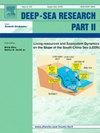基于浮游植物色素和吸收特性的东印度洋浮游植物群落沿物理梯度分布
IF 3
3区 地球科学
Q2 OCEANOGRAPHY
Deep-sea Research Part Ii-topical Studies in Oceanography
Pub Date : 2025-02-06
DOI:10.1016/j.dsr2.2025.105460
引用次数: 0
摘要
2019年5月至6月,“R/V调查员”号在印度洋东南部沿东经110°测量了浮游植物的色素和吸收特性。从40°S左右的中营养条件(叶绿素浓度约为0.5 mg m−3)到10°S附近的寡营养条件(0.04 mg m−3),沿3300 km的样带收集数据。对浮游植物吸收数据进行了聚类分析,其中基于吸收的聚类可作为识别不同浮游植物色素组合及其在水体中的深度的参考。由此产生的集群反映了浮游植物色素组成和色素包装程度的变化,分为不同的组:中营养水域、表面寡营养水域、接近深叶绿素最大值的较深水域和深度超过100米的低叶绿素水域。我们的研究结果证实,在给定的叶绿素浓度下,色素组成对吸收光谱有显著影响。在寡营养条件下,光合色素和光保护色素的比例沿深度变化很大。我们还发现浮游植物在蓝色中的吸收系数低于先前与Chl-a建立的关系所预测的。一般认为,从低营养到中营养的水体中,微浮游植物和微浮游植物的变化方向相反,纳米浮游植物的贡献保持相当稳定,但我们发现,在样带中,微浮游植物的贡献保持稳定且较低(约10%)。我们的研究结果支持利用与色素组成、细胞大小和细胞内色素浓度有关的光学特性来研究不同海洋环境下的浮游植物群落。本文章由计算机程序翻译,如有差异,请以英文原文为准。
Phytoplankton communities distribution along a physical gradient in the eastern Indian Ocean based on their pigments and absorption properties
Phytoplankton pigments and absorption properties were measured along 110° E in the southeast Indian Ocean during a research voyage carried out on R/V Investigator in May–June 2019. The data set was collected along a 3300 km transect starting from mesotrophic conditions around 40° S (chlorophyll concentration of about 0.5 mg m−3) to oligotrophic conditions (0.04 mg m−3) near 10° S. A cluster analysis was applied to phytoplankton absorption data, in which the absorption-based clusters serve as a reference for identifying different phytoplankton pigment assemblages and their depth in the water column. The resulting clusters reflect variations in phytoplankton pigment compositions and degrees of pigment packaging, categorised into distinct groups: mesotrophic waters, surface oligotrophic waters, deeper waters near the deep chlorophyll maxima and low-chlorophyll waters at depths exceeding 100 m. Our results confirm that pigment composition has a significant impact on the absorption spectra for given chlorophyll concentrations. In oligotrophic conditions, the proportions of photosynthetic and photoprotective pigments show large variations along depth. We also found that the phytoplankton absorption coefficient in the blue is lower than predicted by relationships previously established with Chl-a. When pico- and micro-phytoplankton are generally expected to vary in opposite ways from oligo-to meso-trophic waters, with the contribution of nano-phytoplankton remaining quite stable, we here found that pico- and nano-phytoplankton were the varying fractions along the transect, with the contribution of micro-phytoplankton remaining stable and low (about 10%). Our results support the use of optical properties, which are linked to pigment composition, cell size, and intracellular pigment concentration to study phytoplankton communities across varied oceanographic regimes.
求助全文
通过发布文献求助,成功后即可免费获取论文全文。
去求助
来源期刊
CiteScore
6.40
自引率
16.70%
发文量
115
审稿时长
3 months
期刊介绍:
Deep-Sea Research Part II: Topical Studies in Oceanography publishes topical issues from the many international and interdisciplinary projects which are undertaken in oceanography. Besides these special issues from projects, the journal publishes collections of papers presented at conferences. The special issues regularly have electronic annexes of non-text material (numerical data, images, images, video, etc.) which are published with the special issues in ScienceDirect. Deep-Sea Research Part II was split off as a separate journal devoted to topical issues in 1993. Its companion journal Deep-Sea Research Part I: Oceanographic Research Papers, publishes the regular research papers in this area.

 求助内容:
求助内容: 应助结果提醒方式:
应助结果提醒方式:


